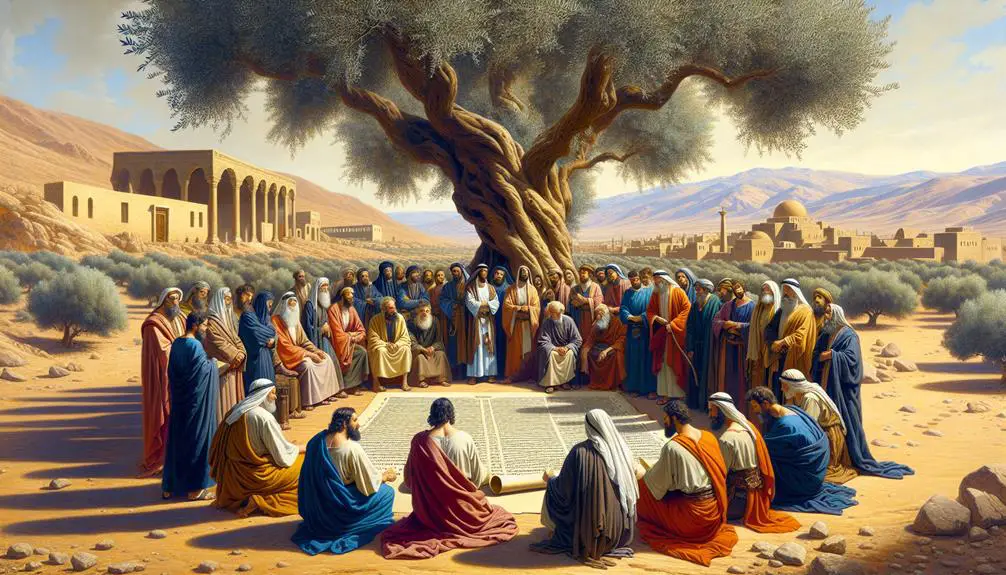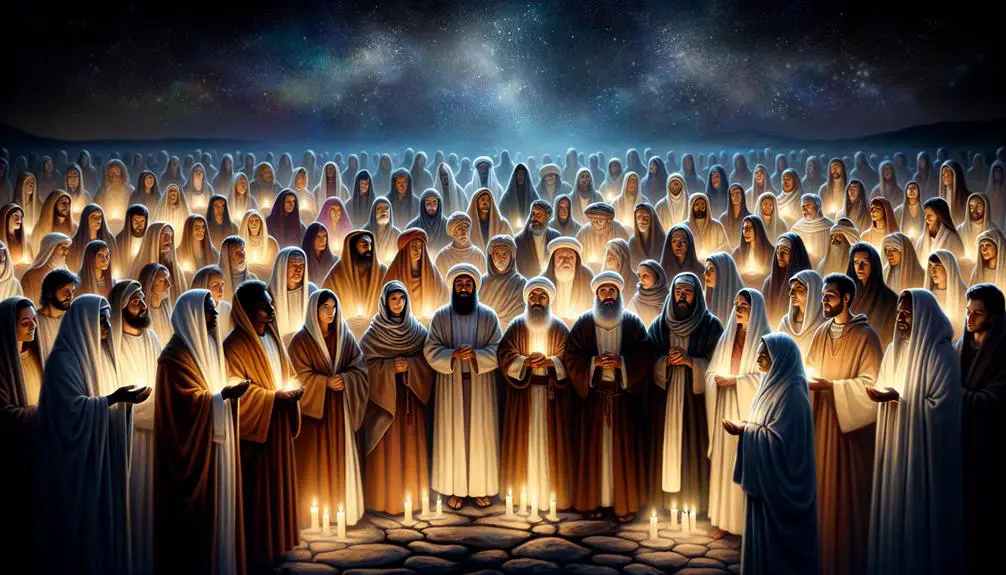Unlock the ancient secrets of biblical chanting, exploring its profound impact on spirituality and how it continues to inspire today.
Chanting in the Bible
Have you ever considered how deeply chanting is woven into the fabric of biblical tradition?
You'll find that the origins of biblical chanting stretch back to ancient practices, with the Psalms offering a rich tapestry of lyrical devotion that has influenced countless generations.
From prophetic declarations to the hymns and songs of the New Testament, chanting serves as a bridge connecting the faithful across millennia.
As you explore this fascinating topic, you'll uncover how modern practices and interpretations continue to draw from these ancient roots, offering a timeless connection to the divine that beckons for a closer look.
Key Takeaways
- Chanting played a critical role in preserving and interpreting biblical texts, often involving musical notations and vocal techniques.
- It served both spiritual and communal purposes, enhancing the emotional and spiritual resonance of prophetic messages and facilitating participation.
- The practice has evolved over time, influenced by theological, cultural, and technological changes, while respecting original melodies and texts.
- Modern approaches to chanting blend ancient traditions with contemporary harmonies and global influences, enriching worship and engagement.
Origins of Biblical Chanting

The origins of biblical chanting can be traced back to ancient Jewish liturgical practices, where it served as a pivotal method for preserving and transmitting sacred texts. This tradition, deeply rooted in the fabric of religious ceremonies, utilized a unique blend of musical notations and vocal techniques to ensure the accurate conveyance of scripture. It's essential to understand that these musical notations weren't merely artistic expressions but were developed as a systematic approach to safeguard the integrity of the texts through generations.
As you delve deeper into the historical context, you'll find that cultural influences played a significant role in shaping the evolution of biblical chanting. These influences weren't monolithic; rather, they varied widely across different regions and periods. Interaction with neighboring cultures, such as the Babylonians and Greeks, introduced new elements into the chant, reflecting a complex interplay between maintaining tradition and incorporating external musical practices.
Analyzing the development of biblical chanting, scholars have identified that the absence of a standardized musical notation system in the earliest periods led to a rich diversity in chanting styles. This diversity is a testament to the adaptability of the practice, allowing it to thrive across different Jewish communities. Each community would have its variation, influenced by local customs and the linguistic nuances of their Hebrew dialects.
Chanting in the Psalms

Delving into the Psalms, one finds that chanting plays a crucial role in their structure and interpretation, serving not only as a means of worship but also as a vehicle for preserving the emotional and spiritual essence of these texts. The Psalms, often attributed to Davidic authorship, incorporate a rich tapestry of musical instruments, suggesting that their original delivery wasn't merely spoken but chanted or sung. This musicality underpins the Psalms' capacity to convey a wide range of human emotions, from despair to exultation, in a manner that transcends the limitations of spoken word.
Chanting, in the context of the Psalms, serves as a bridge between the ancient and the contemporary, enabling a timeless connection to the divine. The use of musical instruments, as documented within these texts, not only enhances this connection but also underscores the importance of chant as a multifaceted form of worship. The Davidic authorship of many Psalms suggests a deliberate intertwining of music and spirituality, reflecting a profound understanding of chant's power to elevate the soul.
Moreover, the structural elements of the Psalms, such as parallelism and repetition, lend themselves naturally to chanting. These features, combined with the inherent musicality suggested by references to instruments, indicate that the Psalms were designed for vocal performance. Such performances, likely accompanied by instruments, would have allowed the faithful to experience the Psalms not just as poetry but as a communal act of worship, deeply embedded in the rituals and spiritual practices of the time.
Prophetic Declarations and Chanting

Prophetic declarations in the Bible often incorporate chanting, a practice that not only amplifies their spiritual resonance but also embeds these messages deeply within the collective consciousness of the faithful. As you explore these ancient texts, you'll notice that prophets didn't merely speak; they employed a range of chanting techniques to convey divine messages with greater impact. This wasn't just a stylistic choice. Chanting facilitated a profound connection between the prophet, their message, and their audience, transcending the ordinary bounds of communication.
To understand this better, consider the following table which highlights key aspects of chanting in prophetic declarations:
Aspect |
Importance |
Relation to Vocal Health |
|---|---|---|
Repetition |
Enhances memorability |
Reduces strain through familiar patterns |
Tone |
Conveys emotional depth |
Encourages controlled breathing |
Rhythm |
Facilitates communal participation |
Prevents vocal fatigue by pacing |
Volume |
Attracts attention, signifies urgency |
Teaches modulation to avoid damage |
Pause |
Emphasizes significance |
Allows vocal rest and reflection |
Analyzing these elements reveals that chanting was not only a spiritual exercise but also a physically attuned practice. Prophets knew intuitively what modern vocal coaches affirm: sustainable vocal health is crucial for effective communication. Thus, the techniques they adopted served dual purposes – enhancing the spiritual potency of their messages while ensuring their ability to continue their divine mandate without overstraining their voices.
New Testament Hymns and Songs

Moving beyond the Old Testament, it's crucial to explore how New Testament hymns and songs further embody spiritual practices through their lyrical depth and communal engagement. These compositions, often embedded within the text of the New Testament, serve not just as doctrinal affirmations but as expressions of early Christian worship and identity. Unlike the Old Testament, which contains explicit songs and prayers, the New Testament's approach to music is more interwoven with its narrative and teachings, reflecting the evolving nature of worship in the Apostolic traditions.
The New Testament doesn't provide musical notation for these hymns and songs. However, their inclusion within the texts suggests an established practice of singing within early Christian communities. This practice likely drew from Jewish traditions and was adapted to reflect the new theological emphases of Christianity.
Key aspects of New Testament hymns and songs include:
- Lyrical content that focuses on Christ's life, death, and resurrection, emphasizing the fulfillment of Old Testament prophecy.
- Function as communal acts, where singing serves to unify the congregation and reinforce shared beliefs.
- Role in catechesis, teaching and reinforcing theological concepts through memorable and repeatable verses.
- Reflection of Apostolic traditions, indicating an early and widespread practice of incorporating music into Christian worship.
Through these characteristics, New Testament hymns and songs not only provide insight into early Christian worship but also demonstrate the continuity and adaptation of musical practices from the Old Testament to the new covenant community. Their study offers a window into the spiritual life and communal identity of the early church.
Modern Practices and Interpretations

In the context of modern Christianity, the practice and interpretation of biblical chanting have evolved, reflecting changes in theological understanding, cultural influences, and technological advancements. You'll find that choral adaptations and the digital resurgence have significantly impacted how these ancient practices are perceived and implemented today.
Choral adaptations have allowed ancient chants to breathe new life, resonating within the walls of contemporary worship spaces. These adaptations respect the original melodies and texts but often incorporate modern harmonies and rhythms, making them more accessible and engaging for today's congregations.
The digital resurgence has also played a pivotal role in the revival of biblical chanting. Easy access to recordings and resources has democratized the learning process, allowing individuals outside the traditional church choirs to explore and engage with these practices.
Aspect |
Impact on Modern Practices |
|---|---|
Choral Adaptations |
Enhanced accessibility and engagement with traditional chants |
Digital Resurgence |
Democratized learning and participation |
Theological Understanding |
Deepened appreciation for liturgical roots |
Cultural Influences |
Integration of diverse musical styles |
This table showcases how various factors contribute to the evolving landscape of biblical chanting in the modern era.
Analyzing these developments, it's clear that while the core essence of biblical chanting remains, its form and function have been shaped by contemporary needs and sensibilities. The fusion of tradition with innovation ensures that these ancient practices continue to be a vital part of Christian worship, fostering spiritual connections across generations.
Frequently Asked Questions
How Does Chanting in the Bible Differ From Chanting Practices in Other Ancient Religions and Cultures?
You're exploring how chanting differs across various ancient cultures, focusing on origins and cultural comparisons.
Unlike other practices, chanting in the Bible carries unique theological significance, intertwining with narratives and laws.
When comparing, you'll notice that while many cultures use chanting for spiritual connection, the biblical context emphasizes prophetic messages and communal worship.
This distinct approach highlights the deep-rooted differences in how societies view and utilize chanting for religious and cultural purposes.
What Psychological or Emotional Effects Have Studies Shown to Result From the Practice of Biblical Chanting?
Imagine feeling overwhelmed with stress, then finding solace in chanting, a practice shown to significantly reduce anxiety. Studies indicate chanting benefits extend to emotional resonance, creating a profound sense of peace and well-being.
This emotional resonance isn't just fleeting; it fosters a deeper connection with oneself, leading to lasting psychological benefits. Through this lens, chanting emerges not merely as a practice but as a transformative emotional experience.
Are There Specific Times or Occasions Where Chanting Is Considered More Appropriate or Powerful According to Biblical Texts?
You're exploring when chanting holds more significance or power. Scriptural references suggest specific occasions, like religious festivals or moments of collective sorrow, where chanting amplifies its benefits.
This practice, deeply rooted in tradition, isn't arbitrary; it's tied to moments that demand reflection or celebration. By examining biblical texts, you'll find that chanting isn't just an act of faith; it's a tool for enhancing communal and individual experiences during pivotal times.
How Has the Role and Perception of Chanting in the Bible Evolved Within Different Christian Denominations Over Time?
You'll find that over time, different Christian denominations have varied widely in their approach to this tradition. Modern interpretations and cultural adaptations have significantly influenced how it's viewed and practiced.
Some branches have embraced it as a core element of worship, deeply rooted in historical tradition, while others see it as less central, reflecting broader theological and cultural shifts. This evolution reflects a dynamic interplay between tradition, interpretation, and communal identity.
Can Chanting Biblical Texts in Their Original Languages (Like Hebrew or Greek) Enhance the Spiritual Experience, and Why?
Diving into the heart of the matter, chanting biblical texts in their original languages can indeed amplify your spiritual journey. This practice bridges the language barrier, offering a direct connection to the scripture's roots. Chanting benefits include enhanced memorization and a deeper emotional engagement.
Analyzing this through a scholarly lens, the authenticity and resonance of Hebrew or Greek can enrich the experience, making the divine word more palpable and immersive for you.
Conclusion
In analyzing biblical chanting, you've journeyed from its origins to modern interpretations, uncovering its profound presence in the Psalms, prophetic declarations, and New Testament hymns. This exploration reveals how chanting bridges the divine and the human, echoing across time.
It's not merely a historical artifact but a living practice, continuously reinterpreted. Thus, chanting stands as a testament to the enduring power of faith's vocal expression, inviting believers into a shared, timeless spiritual experience.
This analysis underscores chanting's deep-rooted significance and its persistent resonance within faith communities.



Sign up